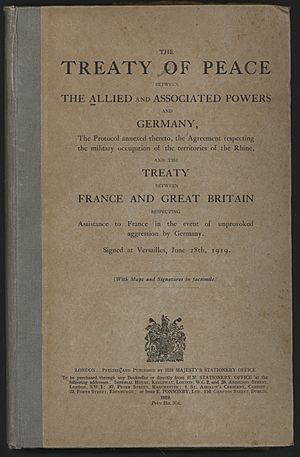Peace treaty facts for kids
A peace treaty is an official agreement that brings an end to a conflict. This conflict is usually between different countries or governments. It often stops armed fights, like a war, or serious disagreements that could lead to war.
A peace treaty is not the same as an armistice. An armistice is just an agreement to stop fighting for a while. It's also different from a surrender, where one side simply gives up.
Making a peace treaty usually happens in a few steps:
- First, there's a lot of talking and discussing. This can take a very long time.
- Next, everyone agrees on the exact words to use in the agreement.
- Finally, the leaders sign the official document.
Peace treaties can cover many different things. They might decide:
- Where the borders between countries will be.
- How to solve future disagreements peacefully.
- How to share important resources, like water.
- What to do with refugees, people who had to leave their homes.
- How to settle any money owed, or debts.
- How many weapons each side is allowed to have.
The First Peace Treaty
The oldest peace treaty we know about was made between two powerful ancient empires: the Hittite and Egyptian empires. This happened after a big battle called the Battle of Kadesh, around 1274 BC. This battle took place in what is now Syria.
At that time, the area called Levant was a disputed land. Both the Egyptian and Hittite empires wanted control of it. After four days of very costly fighting, neither side truly won. Both sides even claimed they were victorious!
However, both rulers, Hattusili III of the Hittites and Ramesses II of Egypt, were worried about more fighting. They decided to end their disagreement and sign a peace treaty. Both empires had other enemies to worry about. Egypt faced threats from tribes in the west, while the Hittites were concerned about the rising Assyrian Empire.
This important peace treaty was written down in two languages. One version was in Egyptian hieroglyphics. The other was in Akkadian, using a writing style called cuneiform. Luckily, both versions still exist today! It was common for treaties to be written in two languages. What's interesting about this treaty is that the two versions are slightly different in how they are worded. Most of the text is the same. But the Hittite version says the Egyptians asked for peace first, while the Egyptian version says the opposite.
The treaty was signed in Ramesses' 21st year as ruler, probably around 1258 BC. It included an agreement to help each other if one empire was attacked by a third group. It also covered what to do if there were problems inside one of the empires. The treaty also had rules about sending refugees back home safely. It said they should not be harmed. Because of this, some people call it the first extradition treaty. The treaty also warned of punishments if either side broke the agreement.
This treaty is so important that a copy of it hangs in the United Nations headquarters today.
Images for kids
See also
 In Spanish: Tratado de paz para niños
In Spanish: Tratado de paz para niños




